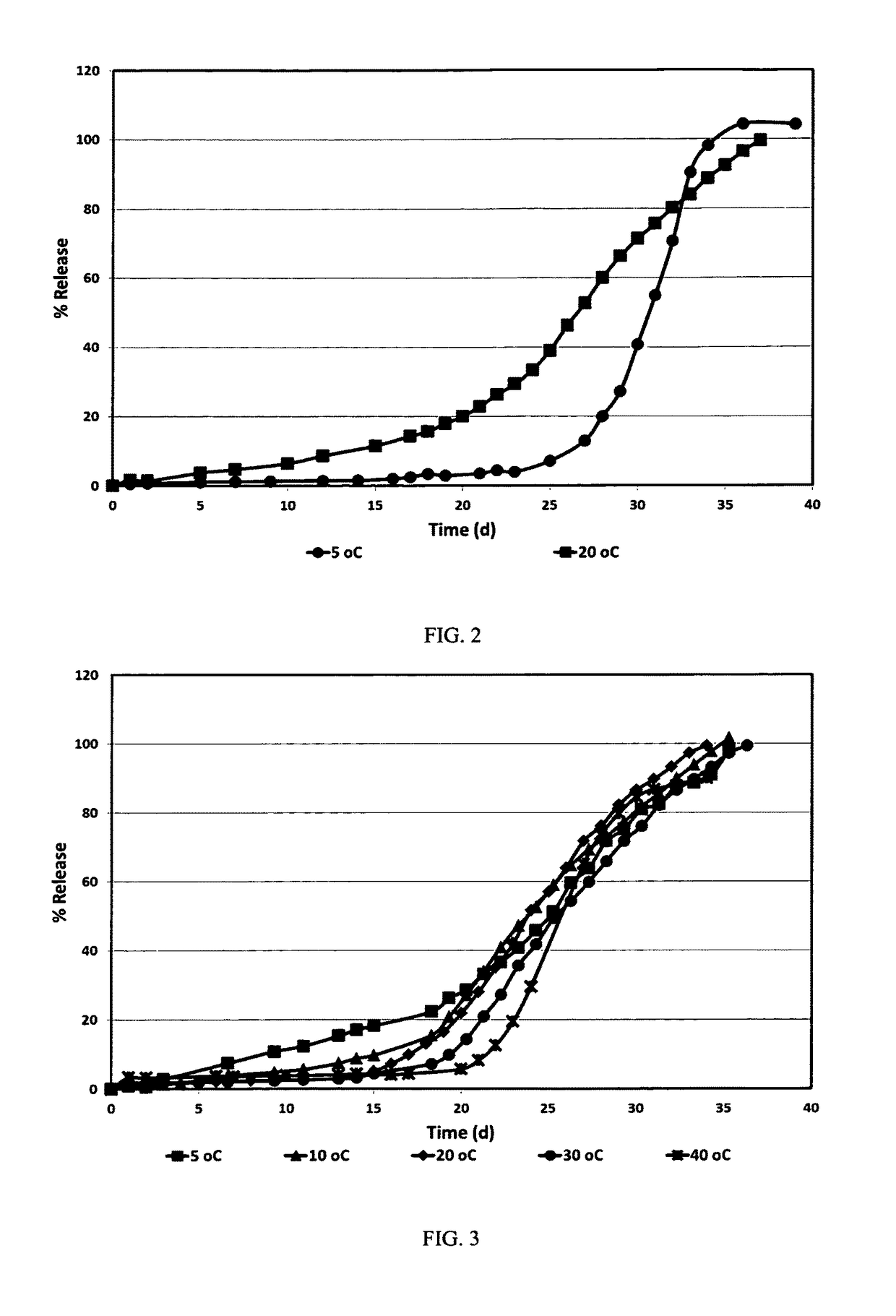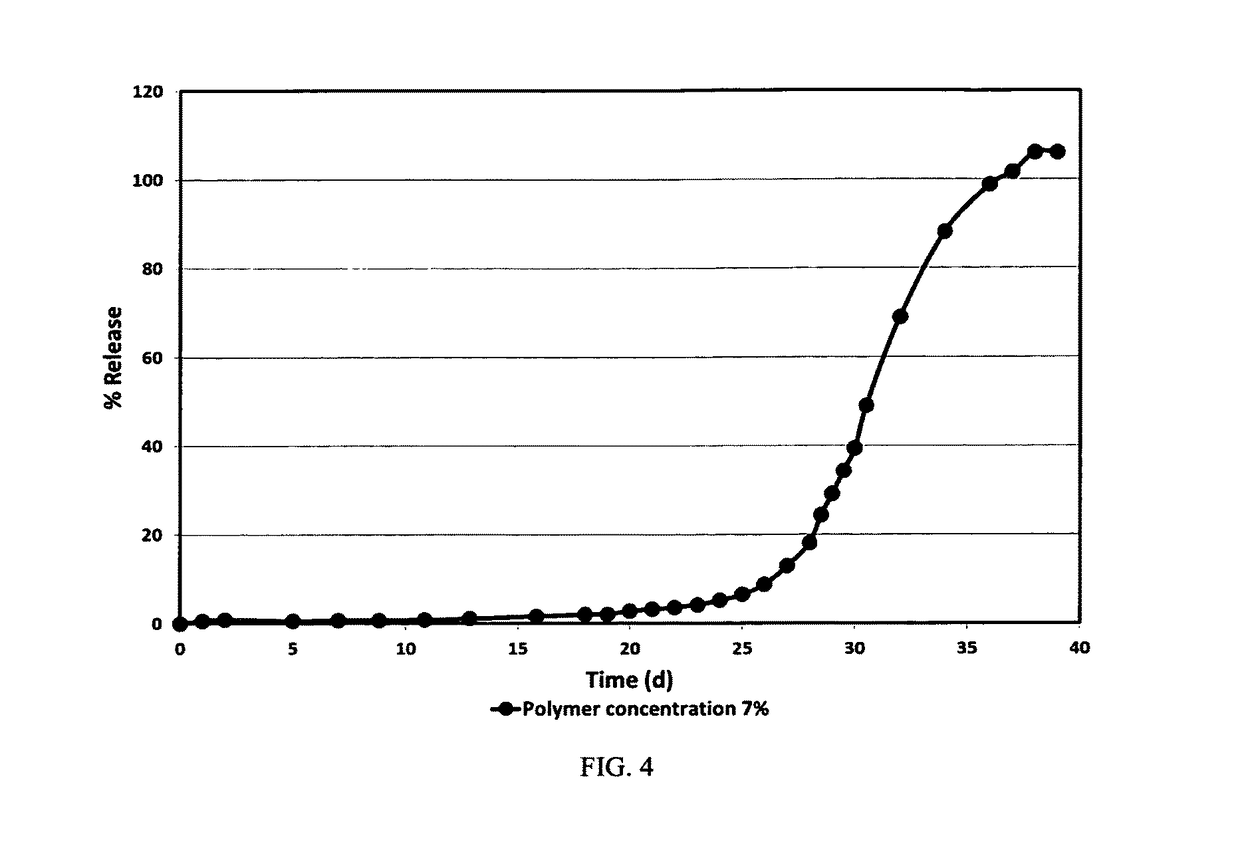Preparation of polylactide-polyglycolide microparticles having a sigmoidal release profile
a technology of polylactide polyglycolide and microparticles, which is applied in the direction of microcapsule preparation, powder delivery, organic active ingredients, etc., can solve the problems of low encapsulation efficiency, inability to avoid drug loss to the continuous phase, and difficulty in scaling up to large-scale manufactur
- Summary
- Abstract
- Description
- Claims
- Application Information
AI Technical Summary
Benefits of technology
Problems solved by technology
Method used
Image
Examples
example 1a & 1b
[0069]For the preparation 1a, 841.5 g of 1% poly(vinyl alcohol) solution (Polyvinyl alcohol 4-88 EMPROVE® exp, Merck Millipore) are mixed together with 61.2 g of dichloromethane, forming an oversaturated outer phase (OP).
[0070]For the preparation of the inner phase (IP), first, 8.1 g of high inherent viscosity (0.76 dl / g) 75:25 poly(D,L lactide-co-glycolide) (commercially available from Purac under the trade name PURASORB PDLG 7507), are dissolved in 81 g dichloromethane, forming a polymer solution of 10% (w / w). Then, and after the complete dissolution of the polymer, 5.4 g of risperidone base are added to the polymer solution and mixed in order to get a clear solution. The two phases are combined together, by using a lab in-line homogenizer (MEGATRON® System MT 3000, Kinematica). The IP and OP are pumped simultaneously at 16.7 ml / min and 220 mL / min, respectively, into the in-line mixer which is set at 800 rpm. The outlet of the homogenizer is introduced directly into a quench media...
example 2a-2e
[0072]420.75 g of 1% poly(vinyl alcohol) solution (Polyvinyl alcohol 4-88 EMPROVE® exp, Merck Millipore) are mixed together with 5.47 g of dichloromethane, forming a saturated outer phase (OP).
[0073]For the preparation of the inner phase (IP), first, 4.05 g of high inherent viscosity (0.76 dl / g) 75:25 PLGA polymer (commercially available from Purac under the trade name PURASORB PDLG 7507), are dissolved in 40.5 g dichloromethane, forming a polymer solution of 10% (w / w). Then, and after the complete dissolution of the polymer, 2.7 g of risperidone base are added to the polymer solution and mixed in order to get a clear solution.
[0074]The two phases are combined together, by the slow addition of the DP in the CP under mechanical stirring at 1200 rpm (IKA overhead stirrer EUROSTAR 20). After 5 minutes of emulsification, the emulsion is transferred slowly into a quench media, composed of 3278.5 g of water for injection, 6.75 g of anhydrous sodium carbonate and 5.4 g of anhydrous sodium ...
example 3
[0077]640.0 g of 1% poly(vinyl alcohol) solution (Polyvinyl alcohol 4-88 EMPROVE® exp, Merck Millipore) are mixed together with 8.32 g of dichloromethane, forming a saturated outer phase (OP).
[0078]For the preparation of the inner phase (IP), first, 4.04 g of high inherent viscosity (0.76 dl / g) 75:25 PLGA polymer (commercially available from Purac under the trade name PURASORB PDLG 7507), are dissolved in 57.77 g dichloromethane, forming a polymer solution of 7% (w / w). Then, and after the complete dissolution of the polymer, 2.7 g of risperidone base are added to the polymer solution and mixed in order to get a clear solution.
[0079]The two phases are combined together, by using a lab in-line homogenizer (MEGATRON® System MT 3000, Kinematica). The IP and OP are pumped simultaneously at 16.67 ml / min and 220 mL / min, respectively, into the in-line mixer which is set at 800 rpm. The outlet of the homogenizer is introduced directly into a quench media, composed of 3300 g of water for inje...
PUM
| Property | Measurement | Unit |
|---|---|---|
| temperature | aaaaa | aaaaa |
| temperature | aaaaa | aaaaa |
| pH | aaaaa | aaaaa |
Abstract
Description
Claims
Application Information
 Login to View More
Login to View More - R&D
- Intellectual Property
- Life Sciences
- Materials
- Tech Scout
- Unparalleled Data Quality
- Higher Quality Content
- 60% Fewer Hallucinations
Browse by: Latest US Patents, China's latest patents, Technical Efficacy Thesaurus, Application Domain, Technology Topic, Popular Technical Reports.
© 2025 PatSnap. All rights reserved.Legal|Privacy policy|Modern Slavery Act Transparency Statement|Sitemap|About US| Contact US: help@patsnap.com



